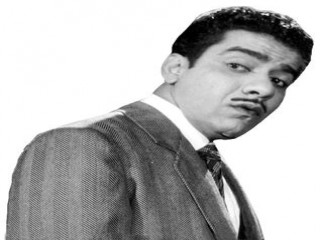
J. P. Chandrababu biography
Date of birth : -
Date of death : -
Birthplace : Tamil Nadu, India
Nationality : Indian
Category : Arts and Entertainment
Last modified : 2011-07-24
Credited as : Comedian actor, singer and dancer,
0 votes so far
He was often likened to the styles of Jerry Lewis, the famous Hollywood comedian-actor. His slapstick style of comedy was then used by later generation actors like Prabhu Deva in Kaadhalan movie. Chandrababu's eloquence in Madras Bashai, a dialect unique to the lower socio-economic status, was incomparable for a long time until Kamal Haasan could do it, a couple of decades later. Many of Chandrababu's songs have remained popular through the generations to this day - to the old and young alike.
Chandrababu was born in 1929, a son of a Christian family from the Paravar community of Tuticorin, India. His father, a freedom fighter, ran a paper called Sudhandhira Veeran which, along with the family assets, was seized by the British government in 1929 when he was arrested for participating in the satyagraha movement. He and the family were exiled to Colombo, Sir Lanka on his release[when?], where his father worked for a Tamil newspaper. Chandrababu was educated at St. Joseph's College, Colombo and Aquinas College prior to his family moving once more, this time to Chennai in 1943. Here they lived in Triplicane, where his father worked for the Dinamani newspaper.
Sri Lanka had a very western outlook in those times and Chandrabubu picked up on western styles of song and dance while there. In these early years, Chandrababu, made acquaintances of the actors Sriram, B. R. Panthulu and, through them, T. R. Mahalingam. They appreciated his talent in singing and mimicry of Hollywood stars such as Charles Boyer. He made his debut with a small role in the 1947 film Dhana Amaravathi but struggled thereafter to obtain parts.
In 1952 he attempted suicide by ingesting copper sulphate crystals in the canteen of Gemini Studio. He had written a suicide note explaining his reasons, which included that he had been unable to meet the director S. S. Vasan, and that his body was to be handed over to B. S. Ramaiah, the director of his only film at that date. Suicide was a criminal offence and so he was arrested. but when his case came to trial the judge asked him to prove his acting ability. Chandrababu rendered a Shakespearean monologue that so impressed the judge that he was not jailed.
One of those who had assisted him in being taken to hospital at the time of his attempted suicide was Gemini Ganesan. When Vasan came to know of this episode he gave Chandrababu a small role in the 1952 film Moondru Pillaigal, the playing of which impressed Vasan so much that he predicted a successful career.
Chandrababu also filmed Chinnadorai and Mohanasundaram in the same year. In Chinnadorai, produced and directed by Mahalingam, he sang the song Poda Raja Podi Nadaya, the first time that yodelling had been heard in Indian film.[citation needed] It is claimed that, as of 2009, he remained the only person capable of yodelling in south Indian cinema.Renowned Indian Actor and Singer Kishore Kumar had apparently learnt the art of yodeling from Chandrababu. Chandrababu loved western music and learned the art of yodelling by listening to singers such as Gene Autry and Hank Williams.
Chandrababu was paid Rs 200 for his role in Mohanasundaram. At his peak he was to command over Rs 100,000, becoming the first Indian actor to do so.
When A. V. Meiyappan filmed Sahodari, he found that it lacked an ingredient that would ensure box office success. Chandrababu was called and after watching the film he added a comedy track for himself, wrote it and also sang the song Naan oru muttalunga, converting the film into a hit.
It was Chandrababu who first spoke and popularised the Madras Baashai in films. He learned this dialect from the rickshaw pullers and street vendors near his home in Triplicane and later in Mir Sahib Pet.
Sabash Meena was one of the best Tamil comedy movies for its times and in it, Chandrababu acted with Sivaji Ganesan, in dual roles.
Chandrababu married Sheila and after their subsequent divorce he continued to offer her support until she left the country. In a business used to sycophancy, he chose not to mince his words and this restricted his opportunities from the 1960s onward. It also caused him to turn to alcohol.
Chandrababu attempted to reverse his financial fortune with a film named Maadi Veettu ezhai, arranging with M. G. Ramachandran as hero. Eventually, he failed on this venture as Ramachandran did not cooperate with him. The film was also dropped. The reasons for Ramachandran's non-cooperation is well explained by script writer Aroordhas, in his 2002 memoirs Naan Muham Paartha Cinema Kannadigal. Its because Chandababu became abusive towards Ramachandran's elder sibling M. G. Chakrapani.
His last work was to direct and act in Thattungal Thirakkappadum, which was highly acclaimed for its cinematography but was not a box office success. He died on March 7, 1974, impoverished but not penniless.
Popular Tamil Songs:
1964 Aandavan Kattalai
1966 Thattungal Thirakkappadum
1967 Valiba Virundhu
1968 Nimirnthu Nil
1972 Neethi
















